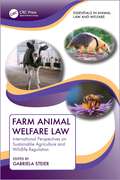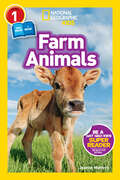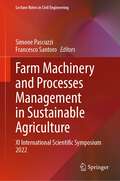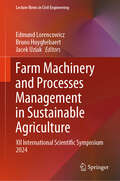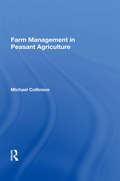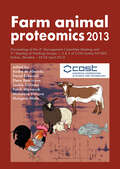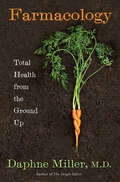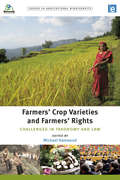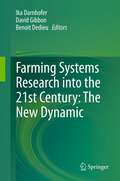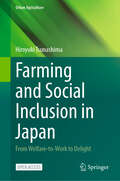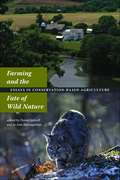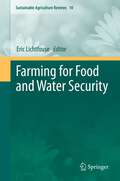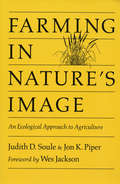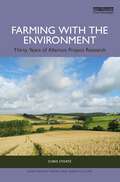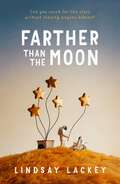- Table View
- List View
Farm Animal Behaviour
by Ingvar EkesboAnimal behaviour is the basis for ascertaining their welfare and is a topic of ever growing importance. This textbook is organised into three sections covering all major farm animals of the world, both mainstream and specialist: large farm animal species (horses, cattle, swine, sheep and goats), poultry and farmed birds and non-domesticated animals such as deer. Each chapter describes the elements of behaviour of a particular species in a clear and uniform format. Background to domestication, innate and learnt behaviour, social behaviour, mating behaviour, activity patterns, senses, behaviour in the young animal, vision and hearing are all covered for each species. Understanding of ethological knowledge is both a necessary aid for getting correct diagnoses, but also for the assessment of health and welfare in the single animal or a group of animals, making the book valuable for veterinary practitioners as well as students at university and tertiary level.
Farm Animal Welfare Law: International Perspectives on Sustainable Agriculture and Wildlife Regulation (Essentials in Animal Law and Welfare)
by Gabriela Steier Sahana Ramdas Christian Mulgrew de Laire Audrey Amescua Amanda G. Verkest Morgan BoutilierThis book introduces the various aspects of international farm animal protection and wildlife conservation through the lenses of food safety and environmental protection law. Bite-sized chapters focus on a wide range of topics from agrobiodiversity, fishing, and aquaculture to pollinators and pesticides, soil management, industrial animal production, and transportation, as well as international food trade. Animal welfare and biodiversity conservation sit at the core of the selected chapters, each one providing real-world examples to make the complex field easy to understand. Current developments including food safety modernization, blockchain, and COVID-19 considerations are addressed head-on. Farm Animal Welfare Law provides a primer for law school courses and masters’ programs, for practitioners, advocates, and animal enthusiasts alike. Through its emphasis on sustainable food production, this book offers a cutting-edge selection of evolving topics at the heart of the pertinent discourse.
Farm Animals (Readers)
by Joanne MatternAdult and child readers will learn all about adorable farm animals together in this new Co-reader from National Geographic Kids.
Farm Machinery and Processes Management in Sustainable Agriculture: XI International Scientific Symposium 2022 (Lecture Notes in Civil Engineering #289)
by Simone Pascuzzi Francesco SantoroThis volume gathers the latest advances, innovations, and applications in the field of sustainable and smart agriculture, as presented by leading researchers at the XI Farm Machinery and Processes Management in Sustainable Agriculture (FMPMSA), held in Bari, Italy on June 13-15, 2022. The volume covers highly diverse topics, including: management of field and livestock production machinery; management of biomass and agroenergy production; plant protection, soil management and agrochemicals application; smart farming and sustainability; ergonomic, labour organization, pandemic impact; sustainable agriculture in the European Union and other countries. The papers, which are published after a rigorous international peer-review process, highlight numerous exciting ideas that will spur novel research directions and foster multidisciplinary collaboration among different specialists.
Farm Machinery and Processes Management in Sustainable Agriculture: XII International Scientific Symposium 2024 (Lecture Notes in Civil Engineering #609)
by Edmund Lorencowicz Bruno Huyghebaert Jacek UziakThis book gathers the latest advances, innovations, and applications in the field of sustainable and smart agriculture, as presented by leading researchers at the XII Farm Machinery and Processes Management in Sustainable Agriculture (FMPMSA), held in Lublin, Poland, on June 12–14, 2024. The book covers highly diverse topics, including: management of field and livestock production machinery; management of biomass and agroenergy production; plant protection, soil management and agrochemicals application; smart farming and sustainability; ergonomic, labor organization; and sustainable agriculture in the European Union and other countries. The papers, which are published after a rigorous international peer-review process, highlight numerous exciting ideas that will spur novel research directions and foster multidisciplinary collaboration among different specialists.
Farm Management In Peasant Agriculture
by Michael CollinsonFirst published in 1972, Farm Management in Peasant Agriculture remains the only detailed discussion of on-site research techniques for economists working on the development of small-holder agriculture in Africa. Part 1 describes the conditions of the agricultural sector within which the African peasant farmer must operate, and then outlines an approach to farm management tailored to those conditions. Part 2 sets out the research planning and investigation tasks implied by the approach. Survey techniques, as well as the value of a pre-survey for understanding general attributes of a farm system, are reviewed, and alternative data-collection methods are elaborated. Part 3 shows how research data can be used in planning content for extension programs. Dr. Collinson concludes with the details of a planning method that interpolates changes in farm practice into a model of the existing farm system and that projects a sequence of changes, representing a sequence of extension content, on the basis of farmer acceptability.
Farm Prices: Myth and Reality
by Willard W. CochraneThis book deals with the price-income problems of commercial agriculture in the United States. The purpose of this book is to bring the best in modern analysis--information, economic logic, and social theory--to bear on the price-income problems of commercial agriculture.
Farm animal proteomics
by David Eckersall André De Almeida Pedro RodriguesProteomics is a field with growing interest in almost every area of life sciences. Proteomic techniques, along with potential and obtained results have long been key components of biomedical and pharmaceutical research. In agriculture, animal and veterinary research however, use of proteomics is still limited, despite the large number of potential applications. As a result, there is a pressing need for wider use and dissemination of proteomics in animal and veterinary science research. This book meets this need by bridging the gap between experts in the technology of proteomics and those at the forefront of research into many facets of animal physiology and pathophysiology. The book encompasses a wide range of topics: from muscle and meat proteomics to acute phase proteins and proteomics in aquaculture, to name but a few. The book summarily presents the state of the art in farm animal proteomics research in Europe, providing readers with interesting examples of the applications of this set of advanced technologies as well as useful contact details of colleagues with expertise in the field. The book will be of interest to scientists at the cutting edge of animal and veterinary research who are currently, or are considering, analytical investigation and identification of protein in animal tissue and in pathogens in health and disease. Furthermore the book will provide an insight for proteomic specialists in demonstrating the breadth of applications that their technology can have in animal and food research.
Farm animal proteomics 2013
by David Eckersall Mangesh Bhide Saskia Dolinska Elena Bencurova Patrik Mlynarcik Miroslava Vincova André De AlmeidaProteomics may be defined as the large-scale study of the proteome, i.e. a set of proteins being expressed in a certain fluid, tissue, organ or organism. Although still of limited and restricted use in most areas of farm animal and veterinary research, proteomics potential is unequivocal holding a significant promise in applications such as vaccine and drug development, animal product quality, physiology or toxicology. Nevertheless, proteomics use has been growing steadily during the last 2-3 years and, as time goes by; proteomics-based studies are more and more common, not just to scientists but to the general public, unraveling their full potential. This book reflects the will of a group of scientists that merge innovation with excellence of research and to whom the dissemination of knowledge and innovation through cooperation is a key essential point. It will be of interest to scientists at the early stages of their careers as well as to researchers well established in the field and to whom proteomics may be the necessary next step towards more in-depth research activities. By providing a collection of diverse scientific interests, Farm Animal Proteomics 2013 is also a witness to the vitality of the area and the importance it holds to animal and food research, to science, industry, government agencies, the consumer and ultimately the society as a whole.
Farm-level Modelling: Techniques, Applications and Policy
by Paul Wilson Maria Espinosa Michael Michael David David Stephen Hynes Sergio Gomez y Paloma Patrick Abbot Maria Maria Arnaud Arnaud Stephen Stephen Filippo Arfini Michele Michele César Revoredo-Giha Cathal Cathal Pavel Pavel Bruce Bruce Wei Wei Wei Wei Thomas Thomas Roberto Solazzo Mario Veneziani Patrick Gillespie Fiona Thorne Thia Hennessy Vera Eory Jinxiu Ding Dr Weiwei Wang Eleonore Guillem Dave Murray-Rust Joana Guimarães Ferreira Alexander GochtAgriculture is the product of a complex mixture of behavioural, biophysical and market drivers. Understanding how these factors interact to produce crops and livestock for food has been the focus of economic investigation for many years. The advent of optimisation algorithms and the exponential growth in computing technology has allowed significant growth in mathematical modelling of the dynamics of agricultural systems. The complexity of approaches has grown in parallel with the availability of data at increasingly finer resolutions. Farm-level models have been widely used in agricultural economic studies to understand how farmers and land owners respond to market and policy levers. This book provides an in-depth description of different methodologies and techniques currently used in farm-level modelling. While giving an overview of the theoretical grounding behind the models, an applied approach is also used. Case studies range from the application of modelling to policy reforms and the subsequent impacts on rural communities and food supply. This book also provides descriptions of the use of farm-level models in much wider fields such as aggregation and linking with sectoral models. Its purpose is to show the reader the methods that have been employed to inform decision-makers about how to improve the economic, social and environmental goals required to achieve the aims of multidimensional policy.
Farmacology: Total Health from the Ground Up
by Daphne MillerWhat can good farming teach us about nurturing ourselves?In Farmacology, practicing family physician and renowned nutrition explorer Daphne Miller brings us beyond the simple concept of "food as medicine" and introduces us to the critical idea that it's the farm where that food is grown that offers us the real medicine.By venturing out of her clinic and spending time on seven family farms, Miller uncovers all the aspects of farming—from seed choice to soil management—that have a direct and powerful impact on our health. Bridging the traditional divide between agriculture and medicine, Miller shares lessons learned from inspiring farmers and biomedical researchers and weaves their insights and discoveries with stories from her patients. The result is a compelling new vision for sustainable healing and a treasure trove of farm-to-body lessons that have immense value in our daily lives.In Farmacology you will meet: a vegetable farmer in Washington state who shows us how the principles he uses to rejuvenate his soil apply just as well to our own bodies. a beef farmer in Missouri who shows how a holistic cattle-grazing method can grow resilient calves and resilient children. an egg farmer in Arkansas who introduces us to the counterintuitive idea that sometimes stresses can keep us productive and healthy. a vintner in Sonoma, California, who reveals the principles of Integrated Pest Management and helps us understand how this gentler approach to controlling unwanted bugs and weeds might be used to treat invasive cancers in humans. a farmer in the Bronx who shows us how a network of gardens offers health benefits that extend far beyond the nutrient value of the fruits and vegetables grown in the raised beds. an aromatic herb farmer back in Washington who teaches us about the secret chemical messages we exchange with plants that can affect our mood and even keep us looking youthful.In each chapter, Farmacology reveals the surprising ways the ecology of our bodies and the ecology of our farms are intimately linked. This is a paradigm-changing adventure that has huge implications for our personal health and the health of the planet.
Farmer Participation And Irrigation Organization
by Bradley W. ParlinThis book elaborates a perspective that can be used to democratize, decentralize, and privatize irrigation organizations. It uses case examples to illustrate the interrelationships between project performance, irrigation organization, and farmer participation.
Farmers' Crop Varieties and Farmers' Rights: Challenges in Taxonomy and Law (Issues in Agricultural Biodiversity)
by Michael HalewoodOver the last 50 years there has been a growing appreciation of the important role that farmers play in the development and conservation of crop genetic diversity, and the contribution of that diversity to agro-ecosystem resilience and food security. This book examines policies that aim to increase the share of benefits that farmers receive when others use the crop varieties that they have developed and managed, i.e., ‘farmers varieties’. In so doing, the book addresses two fundamental questions. The first question is ‘how do farmer management practices – along with other factors such as environment and the breeding systems of plants – affect the evolution and maintenance of discrete farmers’ varieties?’ The second question is ‘how can policies that depend on being able to identify discrete plant varieties accommodate the agricultural realities associated with the generation, use and maintenance of farmers’ varieties?’ This focus on discreteness is topical because there are no fixed, internationally recognized taxonomic or legal definitions of farmers’ varieties. And that presents a challenge when developing policies that involve making specific, discrete farmers’ varieties the subject of legal rights or privileges. The book includes contributions from a wide range of experts including agronomists, anthropologists, geneticists, biologists, plant breeders, lawyers, development practitioners, activists and farmers. It includes case studies from Asia, Africa, Latin America and Europe where, in response to a diversity of contributing factors, there have been efforts to develop policies that provide incentives or rewards to farmers as stewards of farmers’ varieties in ways that are sensitive to the cultural, taxonomic and legal complexities involved. The book situates these initiatives in the context of the evolving discourse and definition of ‘farmers' rights’, presenting insights for future policy initiatives.
Farming Systems Research into the 21st Century: The New Dynamic
by Ika Darnhofer Benoît Dedieu David GibbonFarming Systems Research has three core characteristics: it builds on systems thinking, it depends on the close collaboration between social and biophysical sciences, and it relies on participation to build co-learning processes. Farming Systems Research posits that to contribute towards sustainable rural development, both interdisciplinary collaborations and local actor engagement are needed. Together, they allow for changes in understanding and changes in practices. This book gives an overview of the insights generated in 20 years of Farming Systems Research. It retraces the emergence and development of Farming Systems Research in Europe, summarises the state-of-the-art for key areas, and provides an outlook on new explorations, especially those tackling the dynamic nature of farming systems and their interaction with the natural environment and the context of action.
Farming Systems and Sustainable Agriculture in the Himalaya (Sustainable Development Goals Series)
by Vishwambhar Prasad SatiThe farming system in the Central Himalayan Region is distinctive and unique, mainly focusing on the cultivation of traditional subsistence cereal crops. The agrobiodiversity in this region is rich, with the Central Himalaya growing numerous cultivars and crop races. The practice of cultivating many crops or cultivars in a single field is known as the 'Barahnaja System.' Another peculiar system is the Sar/Sari system, where different crops grow in the two Sars during the same seasons, with one Sar left fallow for six months while the other grows crops. This century-old farming method involves plowing fields with oxen and using organic manure to enhance crop production and productivity. However, recent changes have been observed in the farming systems. The area under traditionally growing millets is declining. In river valleys and middle altitudes, there is a recent trend towards cultivating paddy and wheat. Unfortunately, the cultivation of temperate fruits – apple and citrus has seen a decline in terms of area, production, and productivity. Various factors are influ encing farming systems in the Central Himalaya, such as high climate variability and change, decreasing crop production and productivity, evolving food habits, and out-migration. The book contains 12 chapters illustrating introduction, land use and land cover change, cropping patterns, crop diversity and agro-ecological zones, farming systems and sustainable agriculture, climate change and its impact on agriculture, infrastructural facilities for sustainable agriculture, declining agriculture: a case study, crop productivity and suitability analyzes, agribusiness, policies and planning for sustainable agriculture, and conclusions. It serves as a valuable resource for students, academicians, researchers, policymakers, and farmers.
Farming and Social Inclusion in Japan: From Welfare-to-work to Delight (Urban Agriculture)
by Hiroyuki TsunashimaThis open access book is about a recent movement toward the &“partnership between agriculture and social welfare&” in Japan, which has been based on the idea that the shorthanded agricultural sector offers job opportunities to the people excluded from the existing labor market. The question &“why agriculture for social welfare?&” is worth exploring in an international context. The book examines the results of an action research project initially oriented toward agriculture-related job creation for the homeless elderly and the jobless youth, most of them urban residents. The earlier chapters analyze the relationship among humans as well as between humans and nonhuman life forms on farms, which are essential to understanding of farmwork and the problems in the mainstream labor market. The following chapters highlight the distinct characteristics of the movement based on lessons from this project, resulting in a critique of the welfare-to-work regime and conventional employment assistance. Reviewing literature on the overseas equivalent, care/social farming mainly from Europe, the final part attempts to provide an answer to the question above from a new angle, arguing that work done for the care of life must be delightful. The present study also contributes theoretical support to cognitive science, philosophy of mind, anthropology, politics, and social work science.
Farming and the Fate of Wild Nature
by Daniel Imhoff Jo Ann BaumgartnerFarming and the Fate of Wild Nature addresses an urgent and complex issue facing communities and cultures throughout the world: the need for heightened land stewardship and conservation in an era of diminishing natural resources. Agricultural lands in rural areas are being purchased for development. Water scarcities are pitting urban and development expansion against agriculture and conservation needs. The farming population is ageing and retiring, while those who remain struggle against low commodity prices, international competition, rising production costs, and the threat of disappearing subsidies. We are living amidst a major extinction crisis--much of it driven by agriculture--as well as an increasing shift toward a global urban populace. The modern diet, driven by a grain-fed livestock industry, is no longer connected with the ecosystems that support it. In international circles, experts are arguing that further intensification of agriculture (through industrialization and genetic modification) will be necessary to both feed an exploding human population and to save what is left of wild biodiversity.This book takes up where its predecessor, the award-winning Farming with the Wild, left off. Featuring a wide range of in-depth essays, articles, and other materials by such authors as Aldo Leopold, Wendell Berry, Michael Pollan, Fred Kirschenmann, and Daniel Imhoff, this book persuasively demonstrates that farm and ranch operations which coexist with wild nature are necessary to sustain biodiversity and beauty on the landscape. In fact, as this invaluable educational resource demonstrates, they are essential in the challenge of building sane, healthy, and hopeful human societies.
Farming and the Fate of Wild Nature
by Daniel Imhoff Jo Ann BaumgartnerFarming and the Fate of Wild Nature addresses an urgent and complex issue facing communities and cultures throughout the world: the need for heightened land stewardship and conservation in an era of diminishing natural resources. Agricultural lands in rural areas are being purchased for development. Water scarcities are pitting urban and development expansion against agriculture and conservation needs. The farming population is ageing and retiring, while those who remain struggle against low commodity prices, international competition, rising production costs, and the threat of disappearing subsidies. We are living amidst a major extinction crisis--much of it driven by agriculture--as well as an increasing shift toward a global urban populace. The modern diet, driven by a grain-fed livestock industry, is no longer connected with the ecosystems that support it. In international circles, experts are arguing that further intensification of agriculture (through industrialization and genetic modification) will be necessary to both feed an exploding human population and to save what is left of wild biodiversity.This book takes up where its predecessor, the award-winning Farming with the Wild, left off. Featuring a wide range of in-depth essays, articles, and other materials by such authors as Aldo Leopold, Wendell Berry, Michael Pollan, Fred Kirschenmann, and Daniel Imhoff, this book persuasively demonstrates that farm and ranch operations which coexist with wild nature are necessary to sustain biodiversity and beauty on the landscape. In fact, as this invaluable educational resource demonstrates, they are essential in the challenge of building sane, healthy, and hopeful human societies.
Farming for Food and Water Security
by Eric LichtfouseSustainable agriculture is a rapidly growing field aiming at producing food and energy in a sustainable way for our children. This discipline addresses current issues such as climate change, increasing food and fuel prices, starvation, obesity, water pollution, soil erosion, fertility loss, pest control and biodiversity depletion. Novel solutions are proposed based on integrated knowledge from agronomy, soil science, molecular biology, chemistry, toxicology, ecology, economy, philosophy and social sciences. As actual society issues are now intertwined, sustainable agriculture will bring solutions to build a safer world. This book series analyzes current agricultural issues and proposes alternative solutions, consequently helping all scientists, decision-makers, professors, farmers and politicians wishing to build safe agriculture, energy and food systems for future generations.
Farming in Nature's Image: An Ecological Approach To Agriculture
by Wes Jackson Jon Piper Judy SouleFarming in Nature's Image provides, for the first time, a detailed look into the pioneering work of The Land Institute, the leading educational and research organization for sustainable agriculture.The authors draw on case studies, hands-on experience, and research results to explain the applications of a new system of agriculture based on one unifying concept: that farms should mimic the ecosystems in which they exist. They present both theoretical and practical information, including: a review of the environmental degradation resulting from current farming practices a critical evaluation of the attempts to solve these problems a detailed description of the ecosystem perspective and the proposed new agricultural system a case study illustrating how this new system could be applied to temperate grain production using perennial seed crops and the prairie as a model an examination of the potential savings in energy and water use, as well as potential contributions to ecological experiments and yield analysis work from The Land Institute.Written in clear, non-technical language, this book will be of great interest to soil and agricultural scientists, academics, policymakers, environmentalists, and other concerned with finding long-range solutions to agricultural problems.
Farming with the Environment: Thirty Years of Allerton Project Research (Earthscan Food and Agriculture)
by Chris StoateThis book examines, discusses and shares over 30 years’ worth of research from the Allerton Project, a research and demonstration farm in the UK which has been carrying out applied interdisciplinary research to explore and explain the need to adapt the management of farmland for environmental protection and to provide public benefits. Designed to provide guidance, feedback and recommendations to farmers, practitioners and policymakers, the Allerton Project is an exceptionally well-documented case study of lowland agricultural land management which has the purpose of meeting multiple objectives. This book draws on the wealth of knowledge built over the past 30 years and unveils and clarifies the complexity of a number of topical debates about current land and wildlife management at a range of spatial scales, explores the underlying historical context and provides some important pointers to future directions of travel. Topics include soil health and management, farmland ecology, development of management practices to enhance biodiversity, natural flood management, water quality and aquatic ecology. Most importantly, the book demonstrates how the findings from this project relate to agricultural and conservation policy more broadly as well as how they are applicable to similar projects throughout Europe. This book will be of great interest to professionals working in agricultural land management and conservation, as well as researchers and students of agri-environmental studies and agricultural policy.
Farther Than the Moon
by Lindsay LackeyFrom award-winning author Lindsay Lackey comes Farther Than the Moon, a heartfelt story about a boy who wants to become an astronaut, but wonders if his dreams can include his brother with disabilities, perfect for fans of We Dream of Space and Song for a Whale.All thirteen-year-old Houston Stewart has ever wanted is to become an astronaut. His dreams feel like they're finally coming true when he's accepted to the highly-competitive Junior Astronaut Recruitment Program – if only he could bring his little brother, Robbie, with him.Ever since their dad left, Houston and Robbie have been inseparable. It's hard to tell where Houston's love of space ends and where Robbie's begins. But Robbie's cerebral palsy and epilepsy mean he needs medical attention at home, so Houston must take this giant leap for the two of them all on his own.At camp, Houston is quickly drawn into the orbit of new friends, cosmic adventures, and a long-lost grandfather. But as Houston struggles to meet the program's rigorous demands, he’s forced to reckon with the truth that Robbie may never be able to visit space like the brothers have always hoped. But Houston is determined to honor Robbie’s dream, even if it seems like an impossible mission. So, like a good astronaut, he dares to make a new plan — one that shoots for the stars.Called "a remarkable and heartfelt story that is as fun and gripping as it is profoundly moving" by #1 New York Times-bestselling author Dan Gemeinhart, this is a captivating read for aspiring astronauts and scientists, and a perfect holiday gift.
Fascinating Fungi: Nourishers, Killers, Connectors, and Healers
by Karen Latchana KenneyFrom the ginormous, extinct Prototaxites to the web of mycelium stretching beneath our feet, fungi have always been all around us. Although scientists estimate that only 10 percent of fungi have been discovered, these findings have proved fantastic. Some fungi are toxic. But others are tasty sources of protein or drive the production of bread, cheeses, and fermented drinks. Some make up medicines to treat health conditions. Others connect vast swaths of trees, capture pollutants in the water and soil, or grow into sturdy but lightweight building materials. Many fungi are even fun to look at—they might ooze blood-like sap, glow at night, and more. What else might fungi be able to do? Karen Latchana Kenney digs deep into the expansive fungal world. Learn about how fungi evolved and became their own kingdom. Then explore the many known fungi and how we use them in food, medicine, technology, and more. Entire communities have sprung up around identifying mushrooms—maybe you’ll even be the next member of your local mycological society. From the most well-known mushrooms to the mycelium hidden beneath our feet, this in-depth text digs deep into the incredible fungal world.
Fascinating Science Experiments for Young People (Dover Children's Science Books)
by George BarrThis simply written introduction to scientific research and experimentation takes youngsters into an exciting world where they'll not only learn to discover their own answers to specific problems but will be encouraged to develop sound scientific attitudes and techniques as well.For this volume, noted science educator George Barr has compiled a carefully selected array of intriguing experiments dealing with chemistry, astronomy, magnetism and electricity, weather, water, the human body, living things, sound and light, and measurement. By performing these experiments, young researchers will discover the answers to such questions as "Why Can't We See Stars in the Daytime?" "How Can a Spider Web be Collected?" "Can Water Containing Ice Get Warm?" "How Can We See Sound Vibrations?" "What Helps Your Memory?" and many others.As the author early points out, the work is "not a reading book, but rather a doing book" with a chapter containing suggestions for further experiments. Valuable advice about scientific procedures emphasize the importance of taking readable, organized notes; gathering as much evidence as possible; learning to use "control" groups; and much more. In addition, over 100 illustrations enhance the text, which also contains a selected bibliography of relevant reading material.
Fascination Amazon River: Its People, Its Animals, Its Plants
by Lothar StaeckIn this volume, the Amazon and its adjacent rainforest are presented in all their important facets: First, there is the vast river system itself, with its network of white, black, and clear water rivers. The different water qualities have an enormous impact on people, animals and plants. On the other hand, the people who live along this "Rio Mar," the ocean river, are described. They are the Caboclos, the descendants of the European immigrants and the indigenous people, and it is the different indigenous peoples who have mostly settled along the riverbanks, since the rivers here replace the roads and make contact with other people possible in the first place. Although these ethnic groups have been in contact with Western civilization for generations,they have surprisingly preserved a number of remarkable traditions that are described here. The treasure of the Amazon is its plants and animals. Therefore, the most fascinating flowering plants, including numerous medicinal plants, trees, epiphytes and lianas from different habitats are described in detail and illustrated with excellent photographs. Finally, it is the animals, especially in and around the river, that have always fascinated Alexander von Humboldt. Not only is the lifestyle of the legendary pink dolphins, piranhas and tarantulas explained here, but the impressive amphibians, reptiles and mammals of the jungle are also discussed.epiphytes and lianas from different habitats are described in detail and illustrated with excellent photographs. Finally, it is the animals, especially in and around the river, that have always fascinated Alexander von Humboldt. Not only is the lifestyle of the legendary pink dolphins, piranhas and tarantulas explained here, but the impressive amphibians, reptiles and mammals of the jungle are also discussed.epiphytes and lianas from different habitats are described in detail and illustrated with excellent photographs. Finally, it is the animals, especially in and around the river, that have always fascinated Alexander von Humboldt. Not only is the lifestyle of the legendary pink dolphins, piranhas and tarantulas explained here, but the impressive amphibians, reptiles and mammals of the jungle are also discussed.This book is a translation of the original German 1st edition Faszination Amazonas by Lothar Staeck, published by Springer-Verlag GmbH Germany, part of Springer Nature in 2019. The translation was done with the help of artificial intelligence (machine translation by the service DeepL.com). A subsequent human revision was done primarily in terms of content, so that the book will read stylistically differently from a conventional translation. Springer Nature works continuously to further the development of tools for the production of books and on the related technologies to support the authors.

